Observations
The prototype was tested by eight different persons, and their behaviour towards the game and interface was noted of. We also asked for their feedback to get a clearer picture of which aspects of the game were implemented well and the ones which need further improvement. We advised the users to first start with a simple tutorial which was created with for the purpose of helping the users familiarise themselves with basic game mechanics such as option selection and grabbing objects. The following points describe our observations on the VR prototype:
Certain users skipped the option of the tutorial and had very little knowledge of what they were meant to do in the game. As a result, a forced mini-tutorial should be placed onto the players for the first minute of the game in the form of hints that disappear once a game mechanic is learned.
It was noted that some of the users experienced confusion after finishing the tutorial and starting the actual game. This is because some of the users could not figure out what objects were interactable and which weren't. They were also unaware of the main objective of the game. This problem could be addressed by providing the users with some type of narrative, or adding more to the interfaces by somehow marking the objects which could be interacted with (such as an exclamation mark hovering on the object or a glow effect).
Another observation is that most of the users tried to interact with the wardrobe inside the scene by grabbing the knob, when in reality it should be opened by pressing a button on the menu hovering next to it. This may imply that the grabbing motion is more natural for the users in some cases, instead of choosing options from a menu.
Positive feedback was given about the prototype, as many praised the the overall atmosphere of the room, particularly the small details in the furniture. The atmospheric feel was also enhanced through the background music of the game.
Furthermore, the prototype was found to be pretty engaging and realistic as most users kept wondering around the room trying to interact with more stuff even though they had already interacted with everything they could.
Users were a bit nervous when first trying the game but gained confidence quickly and managed to walk around with the VR set comfortably after a minute. It should be noted that half the users were able to grasp the 'grabbing object' mechanic faster than the other half. Perhaps the addition of a grabbing hand animation would assist users who struggle to perform it at first.

TASK 2
The Scenario Case
Have you ever escaped from an escape room? Or have you ever not managed to escape? If you have, you will know that the thrill of escaping and the frustration of losing will always have you wanting more. However, most people do not have the time or money to play as many escape rooms as they would like.
One might search for a computer escape room game, only to find that it is quite boring and does not provide the same excitement as the real thing due to the lack of interaction with the game setting. In addition to his, a user might feel as though a game is limited in it's story build up and may want to seek a game in which the story is built surrounding the user's choices rather than being set in one possible direction.

OUR SOLUTION
Our game brings all the fun and excitement of an escape room to your own home, giving the users the ability to play whenever they want and repeat the game as many times as they would like. All this is possible using Virtual Reality.
The game offers a unique immersive experience such that players can feel the thrill of being trapped whilst knowing they can snap back to reality whenever they would like. The game will use different VR capabilities such as pointing using the controllers, providing choices to the user based on where they look, interacting with objects and solving puzzles. This will enhance the game experience and absorb the player further into the game.
In addition, the game adapts to the player's actions and decisions. Hence, if a player plays the game twice making different decisions, they could discover different things. This will encourage players to want to play the game multiple times. The adaptivity of the game also helps retain a user's attention, as the game's difficulty will also adapt to the player's actions, preventing the player from getting stuck and bored. Below is a set of storyboards that we have constructed and considered to help model the possible ideas that we can carry out to achieve this solution.
STORY BOARD 1 - STEPHANIE
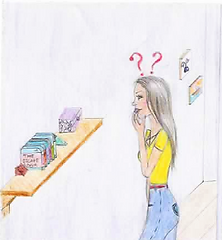

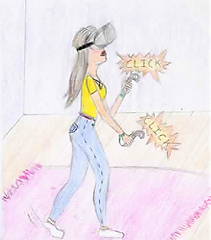
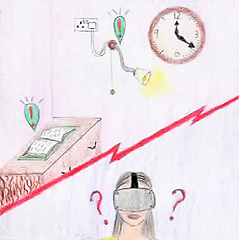
Stephanie returns from work exhausted and is looking for a game to play to spend her evening. Stephanie is not a very technical person when it comes to video games and prefers to be active and more engaged with her surroundings.
Stephanie puts on her VR headset and dual-controllers. She then loads the "The Escape Room" game and finds herself in an escape room environment.
Stephanie is able to interact with the environment with dual controllers. Furthermore, she is able to navigate through the room by walking around (provided she is in a safe space).
When Stephanie is not able to come up with any decisions, the game reduces the difficulty and highlights the possible actions she can take in the room. Stephanie is able to enjoy the game despite not having any technical background.
STORY BOARD 2 - VICTOR
Victor is a video game fanatic, he has bought and played through several games. Victor has replayed certain games but hasn't felt as satisfied whilst doing so as he knew what the outcome of the games will be after playing them once.
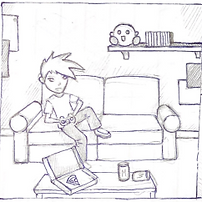

Victor tries the new "The Escape Room" game. He plays the game and carries out certain decisions till he reaches an ending. The game's story adapts to Victor's decisions and tries to make a satisfactory ending based on Victor's play style.

Victor replays the game and carries out different decisions than he did from the previous play through. Victor notices that the game's story changes based on his decisions and manages to replay the game many times whilst maintaining the satisfaction of not knowing the final outcome of each different decision he takes.
STORY BOARD 1 - JENNIFER
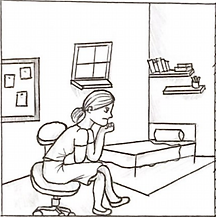
Jennifer buys an Occulus Quest VR headset and is excited to try out games on it. Jennifer comes across games that she is unable to play due to her needing space to move around the room. Unfortunately, Jennifer lives in a very small apartment.

Jennifer comes across the "The Escape Room" game and tries it out. Stephanie notices an option that allows her to select her preferred movement controls (navigating throughout the room or using controllers).

Jennifer is able to enjoy the game and navigate through the room in a preferred and natural manner (for example, using the controllers to move about in the game) whilst still being able to immerse herself within the VR environment.